Complex Wavefront Shaping through a Multi-Core Fiber
Abstract
:1. Introduction
2. Phase Distortion Compensation in a Multi-Core Fiber
3. Complex Wavefront Shaping through a Multi-Core Fiber
4. On-the-Fly Closed-Loop Control of Rotating Profile
5. Discussion
6. Conclusions
Supplementary Materials
Author Contributions
Funding
Institutional Review Board Statement
Informed Consent Statement
Data Availability Statement
Acknowledgments
Conflicts of Interest
References
- Gustafsson, M.G.; Shao, L.; Carlton, P.M.; Wang, C.R.; Golubovskaya, I.N.; Cande, W.Z.; Agard, D.A.; Sedat, J.W. Three-dimensional resolution doubling in wide-field fluorescence microscopy by structured illumination. Biophys. J. 2008, 94, 4957–4970. [Google Scholar] [CrossRef] [PubMed] [Green Version]
- Rubinsztein-Dunlop, H.; Forbes, A.; Berry, M.V.; Dennis, M.R.; Andrews, D.L.; Mansuripur, M.; Denz, C.; Alpmann, C.; Banzer, P.; Weiner, A.M.; et al. Roadmap on structured light. J. Opt. 2016, 19, 013001. [Google Scholar] [CrossRef]
- Wang, D.; Zhou, E.H.; Brake, J.; Ruan, H.; Jang, M.; Yang, C. Focusing through dynamic tissue with millisecond digital optical phase conjugation. Optica 2015, 2, 728–735. [Google Scholar] [CrossRef] [PubMed]
- Koukourakis, N.; Fregin, B.; König, J.; Büttner, L.; Czarske, J.W. Wavefront shaping for imaging-based flow velocity measurements through distortions using a Fresnel guide star. Opt. Express 2016, 24, 22074–22087. [Google Scholar] [CrossRef]
- Koukourakis, N.; Kreysing, M.; Czarske, J. Wavefront shaping method to focus through mouse skull. Adapt. Opt. Anal. Methods Syst. Opt. Soc. Am. 2018, OW2J-3. [Google Scholar] [CrossRef]
- Forouhesh Tehrani, K.; Koukourakis, N.; Czarske, J.; Mortensen, L.J. In situ measurement of the isoplanatic patch for imaging through intact bone. J. Biophotonics 2021, 14, e202000160. [Google Scholar] [CrossRef]
- Aziz, A.; Medina-Sánchez, M.; Koukourakis, N.; Wang, J.; Kuschmierz, R.; Radner, H.; Czarske, J.W.; Schmidt, O.G. Real-time IR tracking of single reflective micromotors through scattering tissues. Adv. Funct. Mater. 2019, 29, 1905272. [Google Scholar] [CrossRef] [Green Version]
- Plöschner, M.; Tyc, T.; Čižmár, T. Seeing through chaos in multimode fibres. Nat. Photonics 2015, 9, 529–535. [Google Scholar] [CrossRef]
- Leite, I.T.; Turtaev, S.; Jiang, X.; Šiler, M.; Cuschieri, A.; Russell, P.S.J.; Čižmár, T. Three-dimensional holographic optical manipulation through a high-numerical-aperture soft-glass multimode fibre. Nat. Photonics 2018, 12, 33–39. [Google Scholar] [CrossRef]
- Rothe, S.; Radner, H.; Koukourakis, N.; Czarske, J.W. Transmission matrix measurement of multimode optical fibers by mode-selective excitation using one spatial light modulator. Appl. Sci. 2019, 9, 195. [Google Scholar] [CrossRef] [Green Version]
- Turtaev, S.; Leite, I.T.; Altwegg-Boussac, T.; Pakan, J.M.; Rochefort, N.L.; Čižmár, T. High-fidelity multimode fibre-based endoscopy for deep brain in vivo imaging. Light. Sci. Appl. 2018, 7, 1–8. [Google Scholar] [CrossRef] [PubMed]
- Ohayon, S.; Caravaca-Aguirre, A.; Piestun, R.; DiCarlo, J.J. Minimally invasive multimode optical fiber microendoscope for deep brain fluorescence imaging. Biomed. Opt. Express 2018, 9, 1492–1509. [Google Scholar] [CrossRef] [PubMed] [Green Version]
- Kreysing, M.; Ott, D.; Schmidberger, M.J.; Otto, O.; Schürmann, M.; Martín-Badosa, E.; Whyte, G.; Guck, J. Dynamic operation of optical fibres beyond the single-mode regime facilitates the orientation of biological cells. Nat. Commun. 2014, 5, 5481. [Google Scholar] [CrossRef] [PubMed] [Green Version]
- Shemirani, M.B.; Mao, W.; Panicker, R.A.; Kahn, J.M. Principal modes in graded-index multimode fiber in presence of spatial-and polarization-mode coupling. J. Light. Technol. 2009, 27, 1248–1261. [Google Scholar] [CrossRef]
- Tsvirkun, V.; Sivankutty, S.; Baudelle, K.; Habert, R.; Bouwmans, G.; Vanvincq, O.; Andresen, E.R.; Rigneault, H. Flexible lensless endoscope with a conformationally invariant multi-core fiber. Optica 2019, 6, 1185–1189. [Google Scholar] [CrossRef] [Green Version]
- Kim, Y.; Warren, S.C.; Stone, J.M.; Knight, J.C.; Neil, M.A.; Paterson, C.; Dunsby, C.W.; French, P.M. Adaptive multiphoton endomicroscope incorporating a polarization-maintaining multicore optical fibre. IEEE J. Sel. Top. Quantum Electron. 2015, 22, 171–178. [Google Scholar] [CrossRef] [Green Version]
- Warren, S.C.; Kim, Y.; Stone, J.M.; Mitchell, C.; Knight, J.C.; Neil, M.A.; Paterson, C.; French, P.M.; Dunsby, C. Adaptive multiphoton endomicroscopy through a dynamically deformed multicore optical fiber using proximal detection. Opt. Express 2016, 24, 21474–21484. [Google Scholar] [CrossRef]
- Kogan, D.; Sivankutty, S.; Tsvirkun, V.; Bouwmans, G.; Andresen, E.R.; Rigneault, H.; Oron, D. Phase retrieval in multicore fiber bundles. Opt. Lett. 2017, 42, 647. [Google Scholar] [CrossRef]
- Stasio, N.; Conkey, D.B.; Moser, C.; Psaltis, D. Light control in a multicore fiber using the memory effect. Opt. Express 2015, 23, 30532–30544. [Google Scholar] [CrossRef]
- Porat, A.; Andresen, E.R.; Rigneault, H.; Oron, D.; Gigan, S.; Katz, O. Widefield lensless imaging through a fiber bundle via speckle correlations. Opt. Express 2016, 24, 16835–16855. [Google Scholar] [CrossRef]
- Conkey, D.B.; Stasio, N.; Morales-Delgado, E.E.; Romito, M.; Moser, C.; Psaltis, D. Lensless two-photon imaging through a multicore fiber with coherence-gated digital phase conjugation. J. Biomed. Opt. 2016, 21, 045002. [Google Scholar] [CrossRef] [PubMed] [Green Version]
- Scharf, E.; Dremel, J.; Kuschmierz, R.; Czarske, J. Video-rate lensless endoscope with self-calibration using wavefront shaping. Opt. Lett. 2020, 45, 3629–3632. [Google Scholar] [CrossRef] [PubMed]
- Czarske, J.W.; Haufe, D.; Koukourakis, N.; Büttner, L. Transmission of independent signals through a multimode fiber using digital optical phase conjugation. Opt. Express 2016, 24, 15128–15136. [Google Scholar] [CrossRef]
- Büttner, L.; Thümmler, M.; Czarske, J. Velocity measurements with structured light transmitted through a multimode optical fiber using digital optical phase conjugation. Opt. Express 2020, 28, 8064–8075. [Google Scholar] [CrossRef]
- Davis, J.A.; Cottrell, D.M.; Campos, J.; Yzuel, M.J.; Moreno, I. Encoding amplitude information onto phase-only filters. Appl. Opt. 1999, 38, 5004–5013. [Google Scholar] [CrossRef]
- Sarkadi, T.; Kettinger, Á.; Koppa, P. Spatial filters for complex wavefront modulation. Appl. Opt. 2013, 52, 5449–5454. [Google Scholar] [CrossRef]
- Cuche, E.; Marquet, P.; Depeursinge, C. Spatial filtering for zero-order and twin-image elimination in digital off-axis holography. Appl. Opt. 2000, 39, 4070–4075. [Google Scholar] [CrossRef]
- Neutsch, K.; Schnitzler, L.; Sun, J.; Tranelis, M.J.; Hofmann, M.R.; Gerhardt, N.C. In-depth particle localization with common-path digital holographic microscopy. Practical Holography XXXIV: Displays, Materials, and Applications. Int. Soc. Opt. Photonics 2020, 11306, 113060A. [Google Scholar]
- Yu, L.; Kim, M.K. Wavelength-scanning digital interference holography for tomographic three-dimensional imaging by use of the angular spectrum method. Opt. Lett. 2005, 30, 2092–2094. [Google Scholar] [CrossRef]
- Yang, G.z.; Dong, B.z.; Gu, B.y.; Zhuang, J.y.; Ersoy, O.K. Gerchberg–Saxton and Yang–Gu algorithms for phase retrieval in a nonunitary transform system: A comparison. Appl. Opt. 1994, 33, 209–218. [Google Scholar] [CrossRef] [PubMed]
- Gerchberg, R. Holography without fringes in the electron microscope. Nature 1972, 240, 404–406. [Google Scholar] [CrossRef]
- Saxton, W. Computer Techniques for Image Processing in Electron Microscopy; Academic Press: Cambridge, MA, USA, 2013; Volume 10. [Google Scholar]
- Jesacher, A.; Maurer, C.; Schwaighofer, A.; Bernet, S.; Ritsch-Marte, M. Near-perfect hologram reconstruction with a spatial light modulator. Opt. Express 2008, 16, 2597–2603. [Google Scholar] [CrossRef] [Green Version]
- Xia, J.; Yin, H. Three-dimensional light modulation using phase-only spatial light modulator. Opt. Eng. 2009, 48, 020502. [Google Scholar] [CrossRef] [Green Version]
- Rothe, S.; Zhang, Q.; Koukourakis, N.; Czarske, J.W. Deep learning for computational mode decomposition in optical fibers. Appl. Sci. 2020, 10, 1367. [Google Scholar] [CrossRef] [Green Version]
- Strasser, F.; Moser, S.; Ritsch-Marte, M.; Thalhammer, G. Direct measurement of individual optical forces in ensembles of trapped particles. Optica 2021, 8, 79–87. [Google Scholar] [CrossRef]
- Rademacher, G.; Luís, R.S.; Puttnam, B.J.; Awaji, Y.; Wada, N. Crosstalk dynamics in multi-core fibers. Opt. Express 2017, 25, 12020–12028. [Google Scholar] [CrossRef]
- Neto, P.M.; Nussenzveig, H. Theory of optical tweezers. EPL Europhys. Lett. 2000, 50, 702. [Google Scholar] [CrossRef] [Green Version]
- Ashkin, A.; Dziedzic, J.M.; Bjorkholm, J.E.; Chu, S. Observation of a single-beam gradient force optical trap for dielectric particles. Opt. Lett. 1986, 11, 288–290. [Google Scholar] [CrossRef] [Green Version]
- Müller, P.; Schürmann, M.; Guck, J. ODTbrain: A Python library for full-view, dense diffraction tomography. BMC Bioinform. 2015, 16, 1–9. [Google Scholar] [CrossRef] [Green Version]
- Abedin, K.; Taunay, T.; Fishteyn, M.; DiGiovanni, D.; Supradeepa, V.; Fini, J.; Yan, M.; Zhu, B.; Monberg, E.; Dimarcello, F. Cladding-pumped erbium-doped multicore fiber amplifier. Opt. Express 2012, 20, 20191–20200. [Google Scholar] [CrossRef] [PubMed] [Green Version]
- Lin, D.; Carpenter, J.; Feng, Y.; Jain, S.; Jung, Y.; Feng, Y.; Zervas, M.N.; Richardson, D.J. Reconfigurable structured light generation in a multicore fibre amplifier. Nat. Commun. 2020, 11, 1–9. [Google Scholar] [CrossRef] [PubMed]
- Lhermite, J.; Suran, E.; Kermène, V.; Louradour, F.; Desfarges-Berthelemot, A.; Barthélémy, A. Coherent combining of 49 laser beams from a multiple core optical fiber by a spatial light modulator. Opt. Express 2010, 18, 4783–4789. [Google Scholar] [CrossRef] [PubMed]
- Kuschmierz, R.; Scharf, E.; Koukourakis, N.; Czarske, J.W. Self-calibration of lensless holographic endoscope using programmable guide stars. Opt. Lett. 2018, 43, 2997–3000. [Google Scholar] [CrossRef] [PubMed]
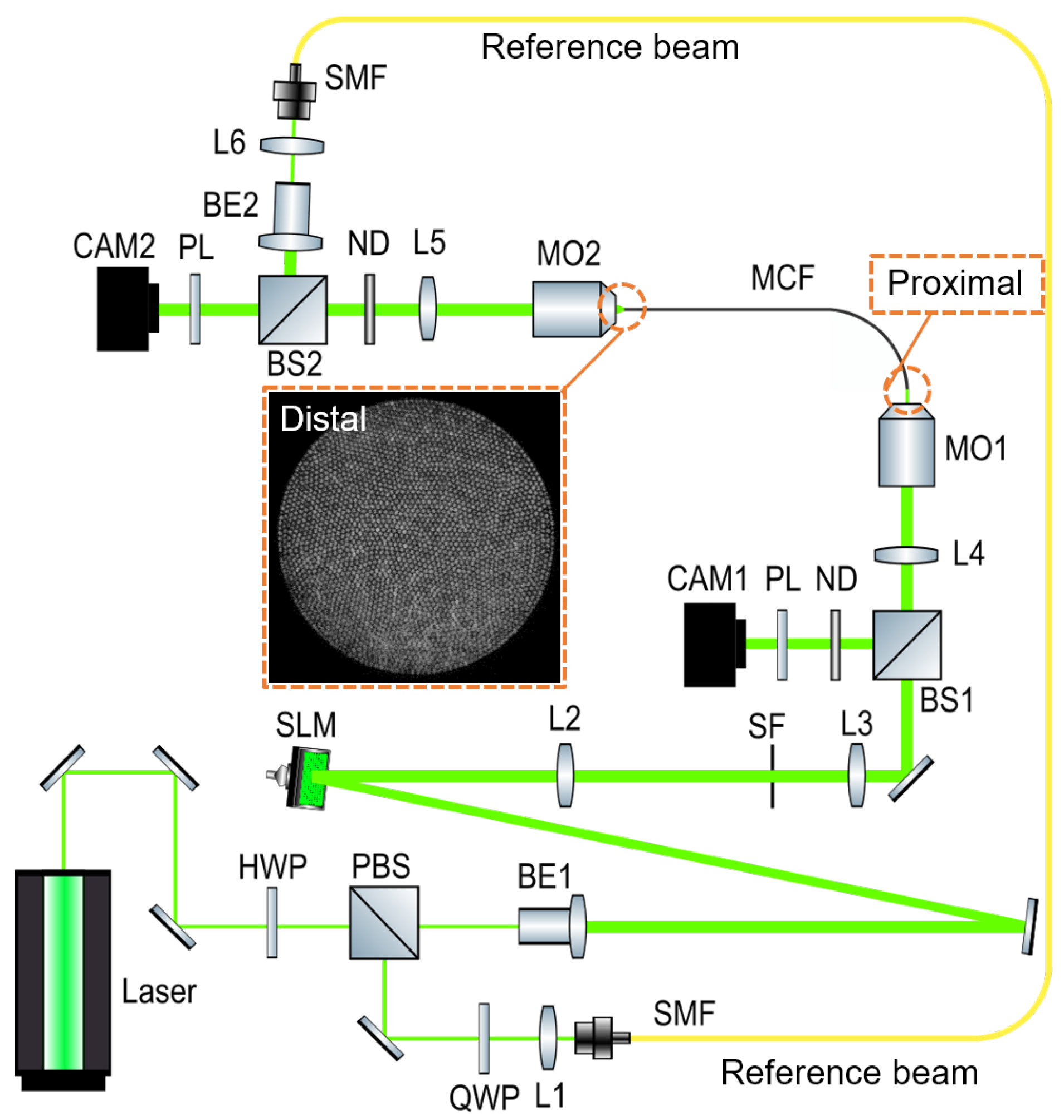

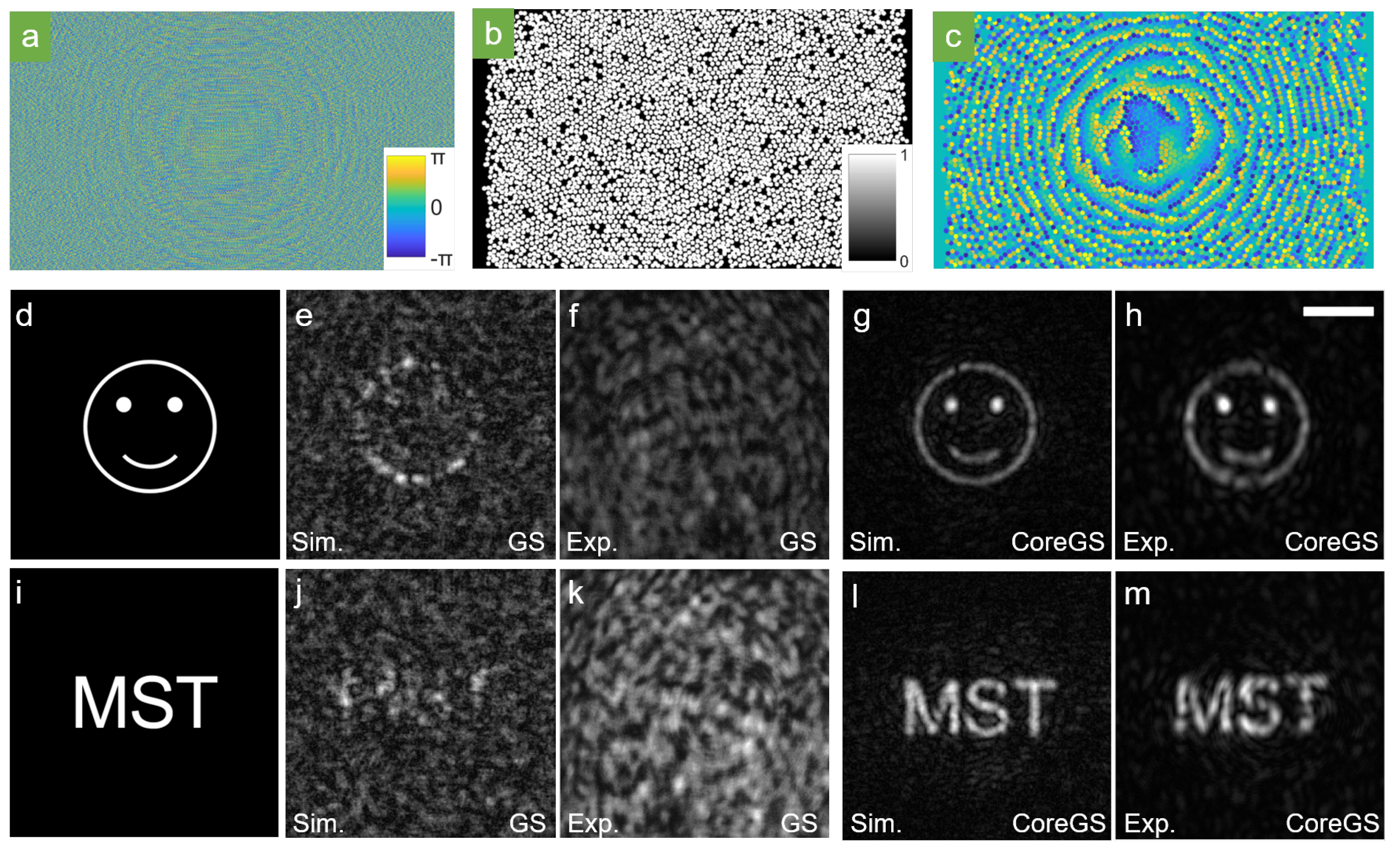
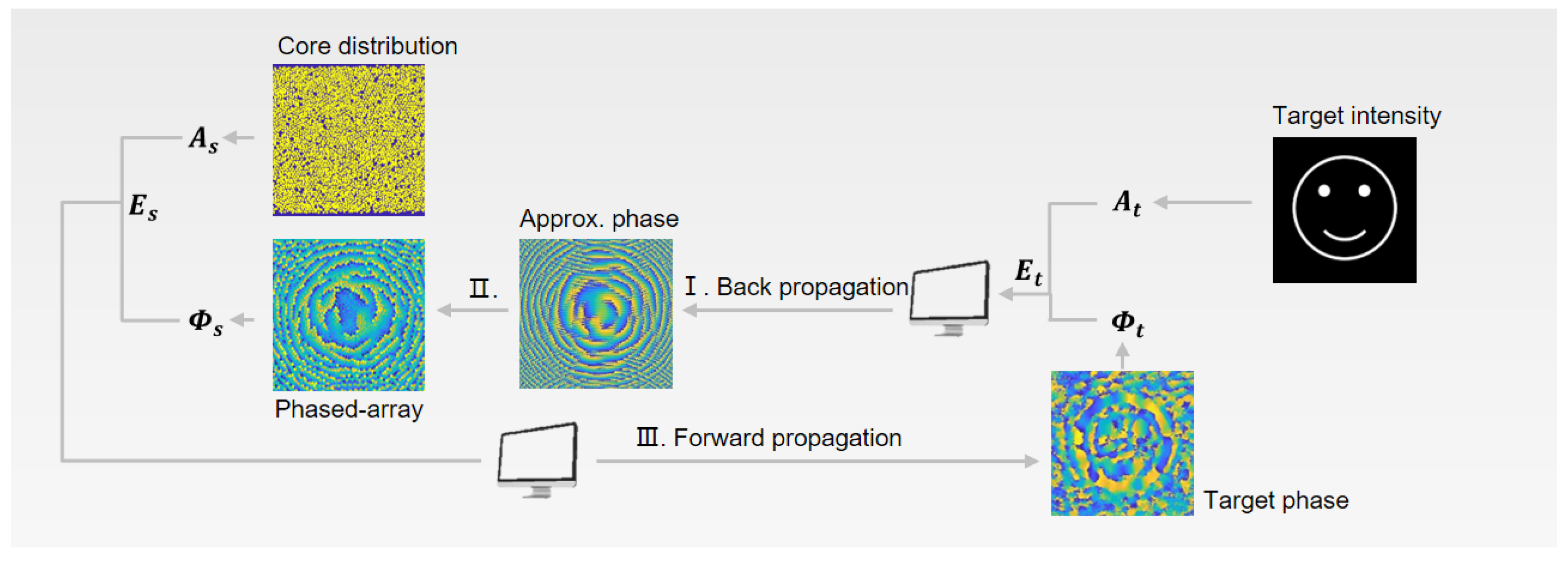

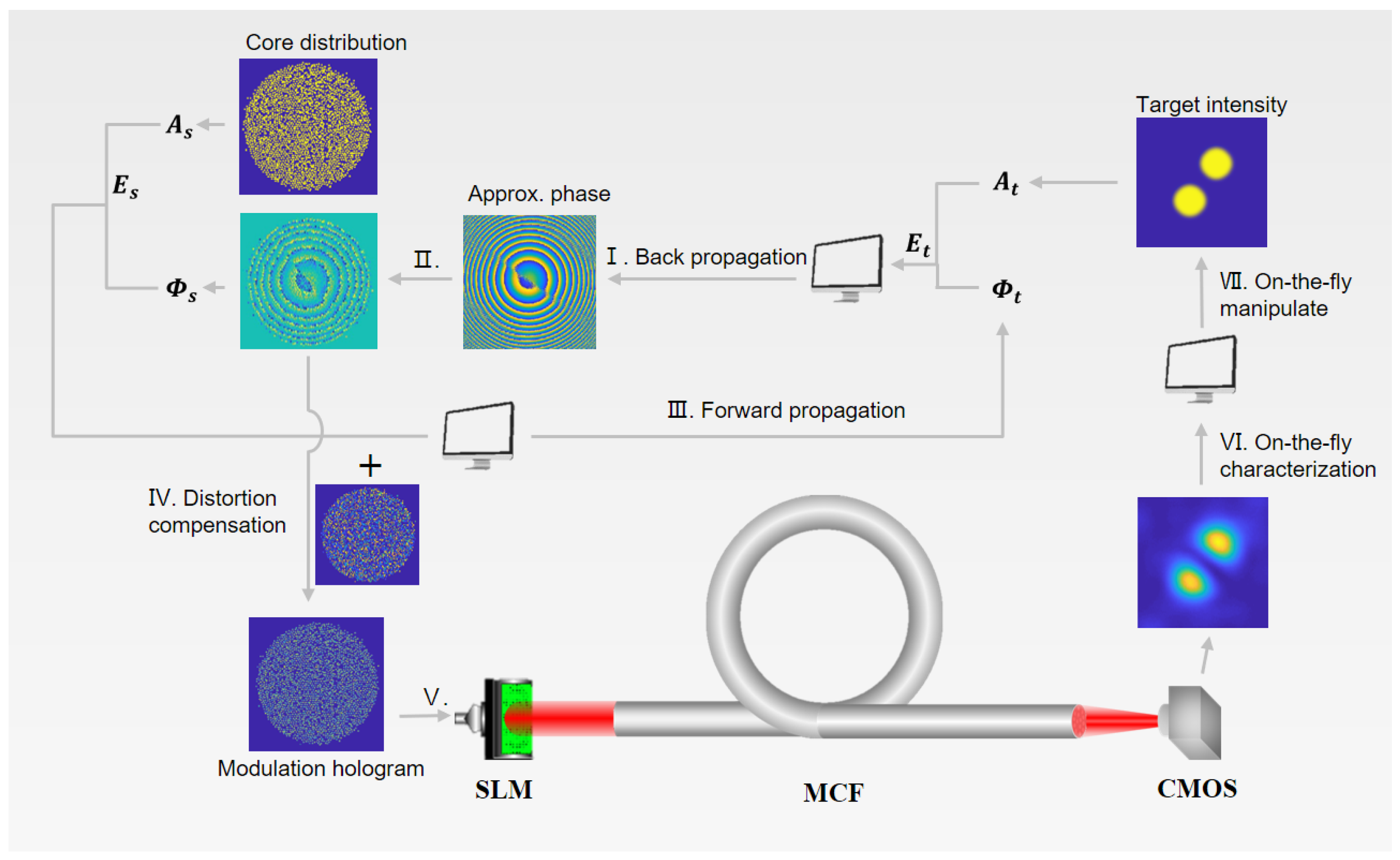

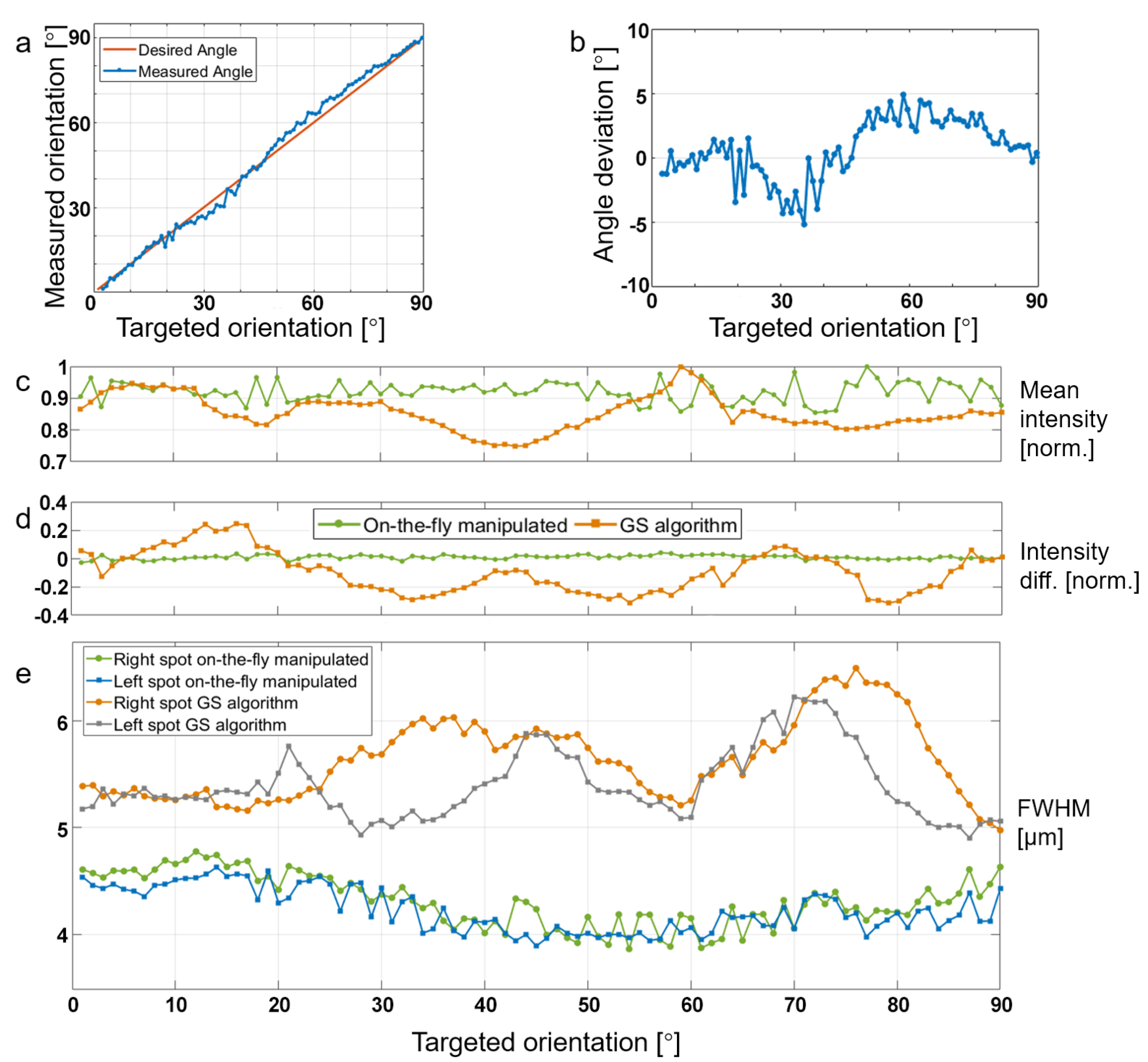
Publisher’s Note: MDPI stays neutral with regard to jurisdictional claims in published maps and institutional affiliations. |
© 2021 by the authors. Licensee MDPI, Basel, Switzerland. This article is an open access article distributed under the terms and conditions of the Creative Commons Attribution (CC BY) license (https://creativecommons.org/licenses/by/4.0/).
Share and Cite
Sun, J.; Koukourakis, N.; Czarske, J.W. Complex Wavefront Shaping through a Multi-Core Fiber. Appl. Sci. 2021, 11, 3949. https://doi.org/10.3390/app11093949
Sun J, Koukourakis N, Czarske JW. Complex Wavefront Shaping through a Multi-Core Fiber. Applied Sciences. 2021; 11(9):3949. https://doi.org/10.3390/app11093949
Chicago/Turabian StyleSun, Jiawei, Nektarios Koukourakis, and Jürgen W. Czarske. 2021. "Complex Wavefront Shaping through a Multi-Core Fiber" Applied Sciences 11, no. 9: 3949. https://doi.org/10.3390/app11093949
APA StyleSun, J., Koukourakis, N., & Czarske, J. W. (2021). Complex Wavefront Shaping through a Multi-Core Fiber. Applied Sciences, 11(9), 3949. https://doi.org/10.3390/app11093949







